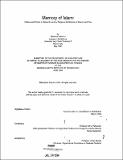Memory of Islam : culture and politics in sixteenth-century religious architecture of Mexico and Peru
Author(s)
Autorino, Salvatore
DownloadFull printable version (16.72Mb)
Alternative title
Culture and politics in sixteenth-century religious architecture of Mexico and Peru
Advisor
Attilio Petruccioli.
Terms of use
Metadata
Show full item recordAbstract
This thesis presents a comparative study of two church typologies employed in the Spanish American colonies during the sixteenth century. The first, developed in Mexico, is the Open Chapel; the second, which I call "Lateral" Church, was very common in Peru and is characterized by the shift of the main entrance from the front to the side of the nave. Their interest lies in the fact that, in a context marked by the spread of Renaissance architecture in Europe and in the American colonies, they represent two among the most anti-classical examples of churches. Furthermore, they are interesting because their anti-classicism can be referred back to the Islamic civilization, which had strongly shaped the history and culture of the Iberian peninsula in eight centuries of continuous presence. The comparison between two different, and not even contemporary contexts aims to reveal of the modifications of cultural expressions in relation to varying degrees of political control. Mexico and Peru, in fact, were discovered, conquered, and populated with different modalities and in different periods within the sixteenth century. This study reaches the following conclusions: 1) Both the Mexican Open chapels and the Peruvian "Lateral" churches reflect, at various degrees, the adoption of a concept of space borrowed from the Hispano-Islamic tradition. 2) The use of such spatial concepts diminishes and becomes very subtle towards the end of the sixteenth century. This phenomenon is tightly related to the re-structuring of the relation Islam and Christendom in Europe, which, in turn, is the result of another process, the "invention" of European cultural identity. In the Americas, in fact, the spread of classic architecture was not only the symbol of the imposition of a new system of power, but also a test for the self-definition of Europe itself. 3) The development of these types in the New World has two overlapping layers of interpretation. First, it can be seen as the reflection of the dialectics of power between the Hispano-Islamic collective cultural heritage and the imperialistic agenda of the colonization, which employed authority and control as its main subjugation tools. Second, it can be seen as a conscious appropriation of forms essentials to the purpose of colonization. These church-types were adopted to display the social and ethnic inferiority of the Indians in front of the conquistadores. 4) Finally, also for the Indians these churches had a double layer of meaning. On the one hand, they represented the architecture of the Spaniards, and therefore the symbol of their subjugation. On the other, these churches provided the forms through which the Natives re -constructed their own identity, in a context marked by the sudden collapse of the traditional cultural structure.
Description
Thesis (M.S.)--Massachusetts Institute of Technology, Dept. of Architecture, 1994. Includes bibliographical references (p. 109-116).
Date issued
1994Department
Massachusetts Institute of Technology. Department of ArchitecturePublisher
Massachusetts Institute of Technology
Keywords
Architecture